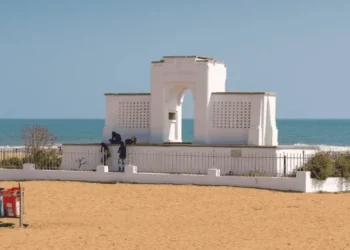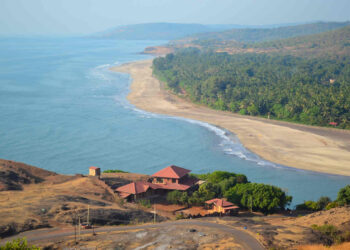Nestled in the heart of Orchha, Madhya Pradesh, by the gentle Betwa River, the Ram Raja Temple is a sacred shrine where devotees worship Lord Rama, Vishnu’s seventh avatar. Commonly known as Orchha Temple, it was constructed around 1570 AD, under Queen Ganesh Kunwari of the Bundela dynasty.
The temple is India’s only shrine where Lord Rama is worshipped as a king, seated in a palace-like hall, served with a daily guard of honor. A Guard of Honour is held every day, police personnel have been designated as Guards at the temple, much in the manner of a king. The food and other amenities provided to the deity at the temple are a royal repast. Armed salutation is provided to God Ram every day.
History of Ram Raja Temple
Old tales say the temple began in 1578 AD when Queen Ganesh Kunwari, wife of King Madhukar Shah, had a vision of Lord Rama. She traveled to Ayodhya, fasting for days, and brought back a Rama idol. While the Chaturbhuj Temple was built to house it, she kept the idol in her palace. When the time came to move it, the idol would not budge, so the palace became the Ram Raja Temple. In the 1600s, Mughal raids tested Orchha, but the temple stayed holy. After 1947, the state and temple trusts took charge, keeping it safe. Repairs have kept its old walls firm, true to its days.
Legend of Ram Raja Temple
The origins of this sacred site go back to the time of King Madhukar Shah Ju Dev, who ruled Orchha from 1554 to 1592. A devoted follower of Lord Krishna, the king often traveled to Vrindavan to seek blessings from Banke Bihari. His queen, Ganesh Kunwari—also known as Kamla Devi—was equally devout, but her heart belonged to Lord Ram.
One day, during a visit to Vrindavan, the royal couple arrived at the Krishna temple only to find it closed. As they waited outside, devotional singing and dancing filled the air. Rather than return to the palace, the king and queen joined the congregation, immersed in the divine atmosphere. Legend has it that Lord Krishna and Radha themselves appeared and danced among the devotees, showering golden flowers from the heavens.
After this divine experience, the king insisted on traveling further to Braj, the sacred land of Krishna. However, the queen longed to visit Ayodhya, the birthplace of Lord Ram. The king, irritated, questioned the devotion she offered to a deity who never appeared before them, unlike Krishna. In frustration, he told her that if she truly believed in Ram, she should bring him to Orchha—specifically in his child form. Only then would he acknowledge her devotion.
The queen took this as a challenge of faith. Without telling the king, she left the palace, barefoot and determined, headed to Ayodhya. Before departing, she instructed her attendants to begin building a grand temple (what would later become the Chaturbhuj Temple) for Lord Ram’s eventual arrival.
Reaching Ayodhya, she settled near Lakshman Fort by the Sarayu River and began her penance. Days passed as she survived on fruits, then only leaves, until she gave up food altogether. Her prayers continued day and night. After about a month with no sign of Ram, she decided to give up her life and leapt into the Sarayu at midnight.
At that moment, something miraculous occurred. Lord Ram appeared in her lap as a child and offered her a boon for her deep devotion. She asked him to return to Orchha with her. Lord Ram agreed, but on three strict conditions: he would travel only during the auspicious period of Pukh Nakshatra, meaning the journey would be long and slow; once he reached Orchha, he would rule as its king, not her husband; and lastly, the very first place where he would be seated must be his final abode.
The queen accepted these conditions. With Ram in child form in her lap, she began the journey back to Orchha, traveling only during Pukh Nakshatra, which meant the trip took eight months and twenty-seven days—between 1574 and 1575. Along the way, she was joined by saints and sages, forming a holy caravan that slowly made its way home.
Back in Orchha, King Madhukar Shah had a dream in which Lord Banke Bihari appeared and chastised him for drawing distinctions between Krishna and Ram, reminding him that both were manifestations of the same divine spirit. The king woke remorseful and, learning of the queen’s return, rushed to welcome her with pomp—elephants, horses, and offerings. But the queen refused his gestures. Holding child Ram in her lap, she declared that she now had everything she ever needed.
The plan had been to place the deity in the newly constructed Chaturbhuj Temple. However, upon her return, the queen rested with the child deity in her palace overnight. True to his word, Lord Ram transformed into an idol and fixed himself at the very spot where he was first placed—the queen’s own royal chambers. Since then, the palace, known as Ranivaas or Rani Mahal, became the Ram Raja Temple.
Interestingly, the original idol was in a standing posture. Each day, the queen would stand for hours to perform her devotions. When Lord Ram asked her to sit, she replied, “If you are standing, how can I sit?” Upon hearing this, Lord Ram is said to have sat down, and the idol miraculously changed into a seated position—something recorded in devotional texts like Bhaktamal by Nabhadasji Maharaj.
Architecture of Ram Raja Temple
The Ram Raja Temple looks like a small palace, not a towering shrine, set low in Orchha’s market. Its square form, with thick walls and a flat roof, has small domes at corners, showing Mughal and Bundela styles. The outer walls, pale yellow, have plain stone work, with arched windows letting in soft light. Inside, the main hall, once a queen’s room, holds the idols of Rama, Sita, Lakshmana, and Hanuman, seated on a simple throne, lit by oil lamps, holy and calm, real holy. The hall’s ceiling has faded flower paintings, fine and neat.
Festivals
The temple certain important Hindu festivals like the Makar Sankranti, Vasant Panchami, Shivratri, Ram Navami, Kartik Purnima and Vivaha Panchami, where the number of devotees throng to Orchha range in thousands. On Ram Navami in April, crowds sing all night, pouring milk for Rama. Diwali in October sees lamps glow for Rama’s return.
How to Get There:
Air: Gwalior Airport, 120 km off, is nearest. Taxis take 2.5 hours.
Train: Jhansi Station, 18 km away, joins Delhi, 6 hours long.
Road: Buses from Jhansi, 30 minutes off, reach Orchha. Taxis cost ₹500–1000.
Best Time to Visit:
October to March, cool air, 15–25°C. Weekdays are quiet, real quiet. Ram Navami is crowded, plan early, plan well.











